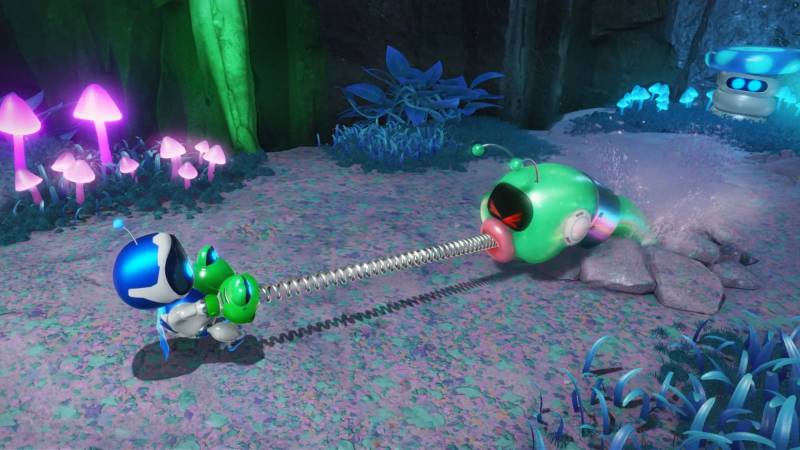
After the disaster of Concord comes the triumph of Sony’s Astro Bot, with a new single-player classic that is one of the best 3D platformers ever made.
Astro Bot may be the best-timed video game release there’s ever been. It’s not intentional, but just days after Sony humiliated itself with the closure of Concord, along comes a PlayStation 5 exclusive dedicated to celebrating the 30 year history of PlayStation. Not only that but it’s a single-player action game with no microtransactions or season passes, or any of the other increasingly invasive hallmarks of modern console gaming.
Despite that, Astro Bot is not a typical Sony first party title. There’s practically no story, no real open world elements, and it’s aimed very much at a family audience – even if it has elements that will be of special interest to veteran PlayStation fans. It also looks and plays very much like a Nintendo game, which is the highest praise you could give any 3D platformer.
It’s easily better than any of the Ratchet & Clank games and, apart from Nintendo, its only real rival is PlayStation VR predecessor Astro Bot Rescue Mission. Although this game could be construed as a sequel to that and certainly shares many similar sequences and characters. It also features dozens of characters from first and third party PlayStation games from throughout the decades – although the way they’re handled is one of the game’s few failings.
The lack of story in Astro Bot reflects the character’s origin in PlayStation 4 tech demos The Playroom and The Playroom VR. As such, he’s never been given any backstory and he only communicates in baby talk. Except for wearing a cape, he looks identical to all the other robots and, quite frankly, he’s beginning to seem under-designed – especially when one of this game’s main gimmicks is dressing him up as other PlayStation characters. But we’ll get into that later.
What set-up there is has Astro and his pals flying around in space, inside a PlayStation 5 console, until they’re captured by what is vaguely described as a ‘space bully’, who steals the console’s five main components and scatters the bots across a variety of worlds.
What results is a 3D platformer very similar to Rescue Mission (which hardly anyone played because it’s VR-only) and Astro’s Playroom (which everyone owns because it’s free with the console). Although the biggest influence here is Super Mario Galaxy and Odyssey.
The levels are well designed and mostly linear, with small open range areas here and there. The controls are extremely simple, with Astro having a double jump and the ability to glide short distances, similarly to Yoshi’s flutter jump, with his little jet boots. The latter can be used to damage enemies from above or Astro has a basic punch attack – all of which is exactly as it’s been in previous games.
The goal of each level is merely to get to the end but secreted within each stage is around half a dozen different bots, at least two or three of which are cosplaying as other characters. Sometimes these are hard to miss but most of the time they’re at least somewhat hidden and, along with jigsaw pieces that unlock things like a gatcha shop and changing room for Astro, are the main rewards for exploration.
Since what you’re actually after is the stolen pieces of the PlayStation 5 there’s always an extra level after each of the main bosses that is inspired by a first party Sony game. You can probably imagine what these are already, with the God Of War one giving you Kratos’ ice axe and the Uncharted one having Nate shooting what looks like foam balls at enemies.
However, two of these levels are based on dormant Sony franchises and if you can avoid having it spoiled for you what they are beforehand, they’re amongst the highlights of the game. They both replicate the mechanics, and audio, of the original games exactly and are an absolute joy, that will instantly have you wishing that they’d get full-blown sequels on the PlayStation 5.

Level themes include the traditional cliches such as lava worlds and slippy-slidey ice worlds, as well as those from Rescue Mission, such as construction yards and plant-filled gardens. It’s slightly less blatant than Rescue Mission, but most of the enemies are very obviously just robotic versions of classic Super Mario enemies, from Goombas to Wigglers, while almost every background object, from giant mushrooms to volcanos, has eyes and is apparently sentient.
The enemies being copycats are a slight shame, but the visual design is very good, with everything also clearly being mechanical, rather than just organic, which looks great when it’s subtly cybernetic trees and animals. The game’s visuals aren’t necessarily pushing the PlayStation 5 but they’re flawless and silky smooth, with not a bug in sight.
What’s most impressive, on a technical level, is the game’s use of force feedback. Surprisingly, the haptic feedback on the shoulder buttons, which was so impressive in Astro’s Playroom, isn’t emphasised but the audio and rumble design is the best we’ve ever seen in a video game. Many things in Astro Bot approach the quality and imagination of a Nintendo game but the use of force feedback surpasses anything on the Switch.
Just walking around generates a gentle rumble, which increases as you use your jet boots or attack enemies. Different surfaces rumble differently, with the excellent audio design matching them perfectly. It’s not just movement though, as the creak of Aloy’s bow and arrow, while aiming in the Horizon level, is insanely satisfying and much better than in the actual game it’s based on.
The tinkle of the robotic armadillo you ride in some levels, as it allows you to travel over spike traps, is so viscerally satisfying it’s impossible not to grin ear to ear every time it happens (even if the rolled-up armadillo itself is clearly inspired by the Star Ball levels from Super Mario Galaxy). While ruminating on the game’s score, which is finally balanced between an 8 and 9, it’s the force feedback and audio design which pushed us over the edge.

Graphics aren’t the only presentational element that can elevate a game, and Astro Bot proves that perfectly, but in gameplay terms the most interesting ideas are the many and varied power-ups. Some are fairly straightforward, like the bulldog rocket that shoots you horizontally forward and can damage objects, while a rooster one can shoot you vertically in the air, which is used to pull objects out of the ground.
Others are less straightforward, such as boxing gloves that concertina out but can also be used to attach to objects (that appear to be covered in jam) to pull them or use them to swing onto other platforms. One power-up can suck up various liquids from the ground to create platforms of different consistencies, while another slows down time and is used in a variety of clever ways.
The most interesting though is probably the one that shrinks you down to the size of a mouse, allowing you to explore levels at two different sizes. It’s just a shame there’s not more of those levels, as that’s when the game is at its peak in terms of game design – along with one-off themes like a day/night world that you can switch between with the press of a button.
The reason we hesitate over the score is that in terms of the actual platforming the game is rather basic. Astro has far less moves than Mario, which reduces the options in terms of level design. The main levels, and even the bosses – which are otherwise very imaginative – are also very easy.
Oddly, Astro can only ever survive one hit, which can be annoying as 90% of the time the only thing that ever kills you is enemies firing projectiles, but the game is so heavily checkpointed it’s never really a problem.
There are much more difficult optional levels – a set based around the face button symbols being the hardest – but these are all quite short and completely linear, with no checkpoints. They’re reminiscent of Super Mario Sunshine void levels but it’s a shame none of the normal levels also offer an increased challenge.
Although the platforming is a little shallow, and we’re surprised that the soundtrack doesn’t build more on the singing levels from Astro’s Playroom, the only real flaw with Astro Bot is the way it handles its PlayStation nostalgia. We’ve discussed that in a separate boxout, because none of that affects the game, but it is all very odd – and gives the distinct impression it was shoehorned in halfway through development.
The irony that Astro Bot is launching on the same day that Concord is being shut down will not be lost on anyone, even though that is essentially a coincidence. But in actuality Astro Bot isn’t a very good celebration of PlayStation’s history. It is, however, one of the best 3D platformers ever made and an absolute joy from beginning to end.
No matter how you feel about live service games, it would be criminal if a continued focus on them meant games like Astro Bot were pushed to the side. The ironic timing of its releases means that’s now unlikely to happen, but it would be unfortunate if Astro Bot was remembered purely as a foil to Concord or as a flawed nostalgia piece. It is, far more importantly, a great game and hugely encouraging for the future of PlayStation.
Formats: PlayStation 5
Price: £59.99
Publisher: Sony Interactive Entertainment
Developer: Team Asobi
Release Date: 6th September 2024
Age Rating: 7

Email gamecentral@metro.co.uk, leave a comment below, follow us on Twitter, and sign-up to our newsletter.
To submit Inbox letters and Reader’s Features more easily, without the need to send an email, just use our Submit Stuff page here.
For more stories like this, check our Gaming page.

Sign up to all the exclusive gaming content, latest releases before they're seen on the site.
Privacy Policy »Disclaimer: The copyright of this article belongs to the original author. Reposting this article is solely for the purpose of information dissemination and does not constitute any investment advice. If there is any infringement, please contact us immediately. We will make corrections or deletions as necessary. Thank you.



